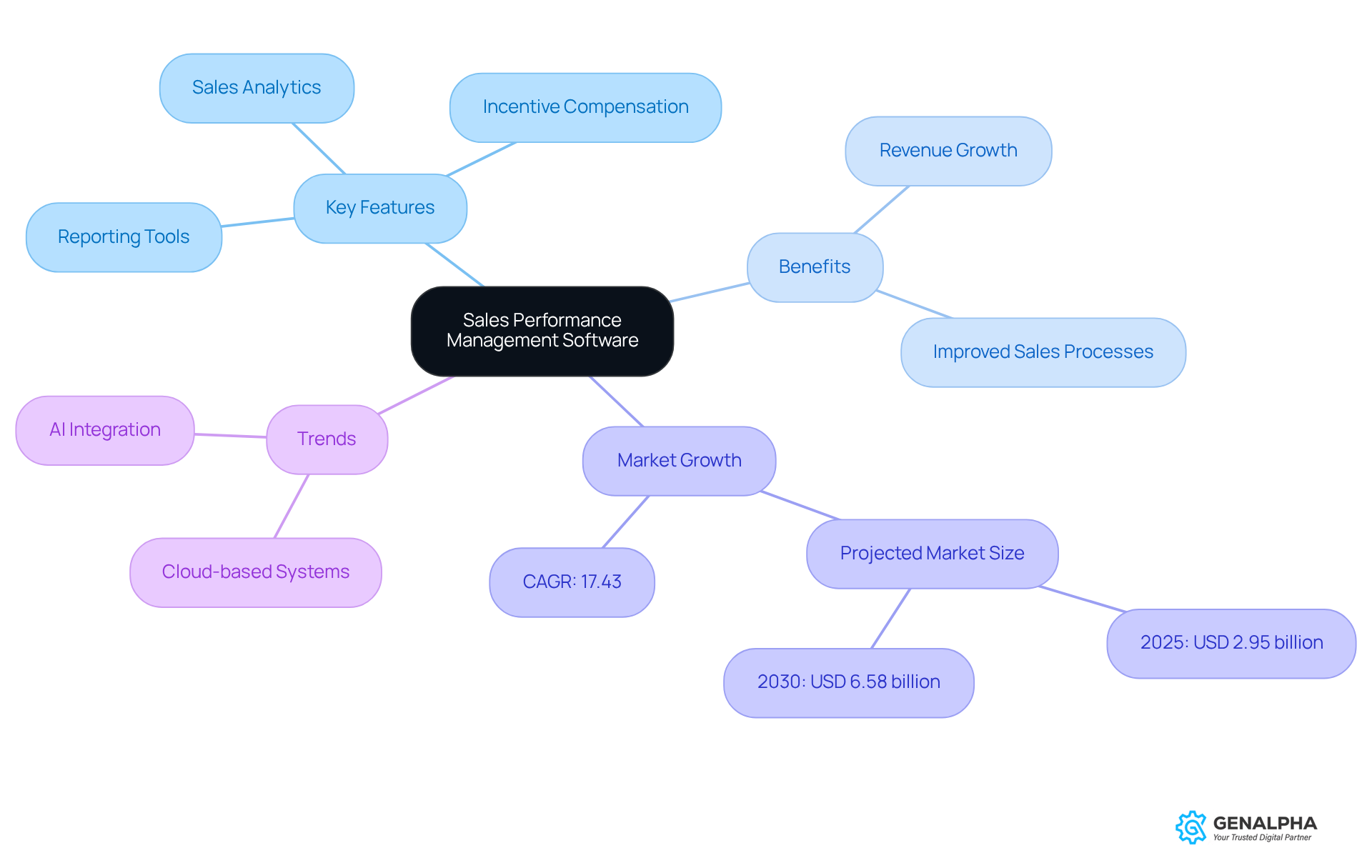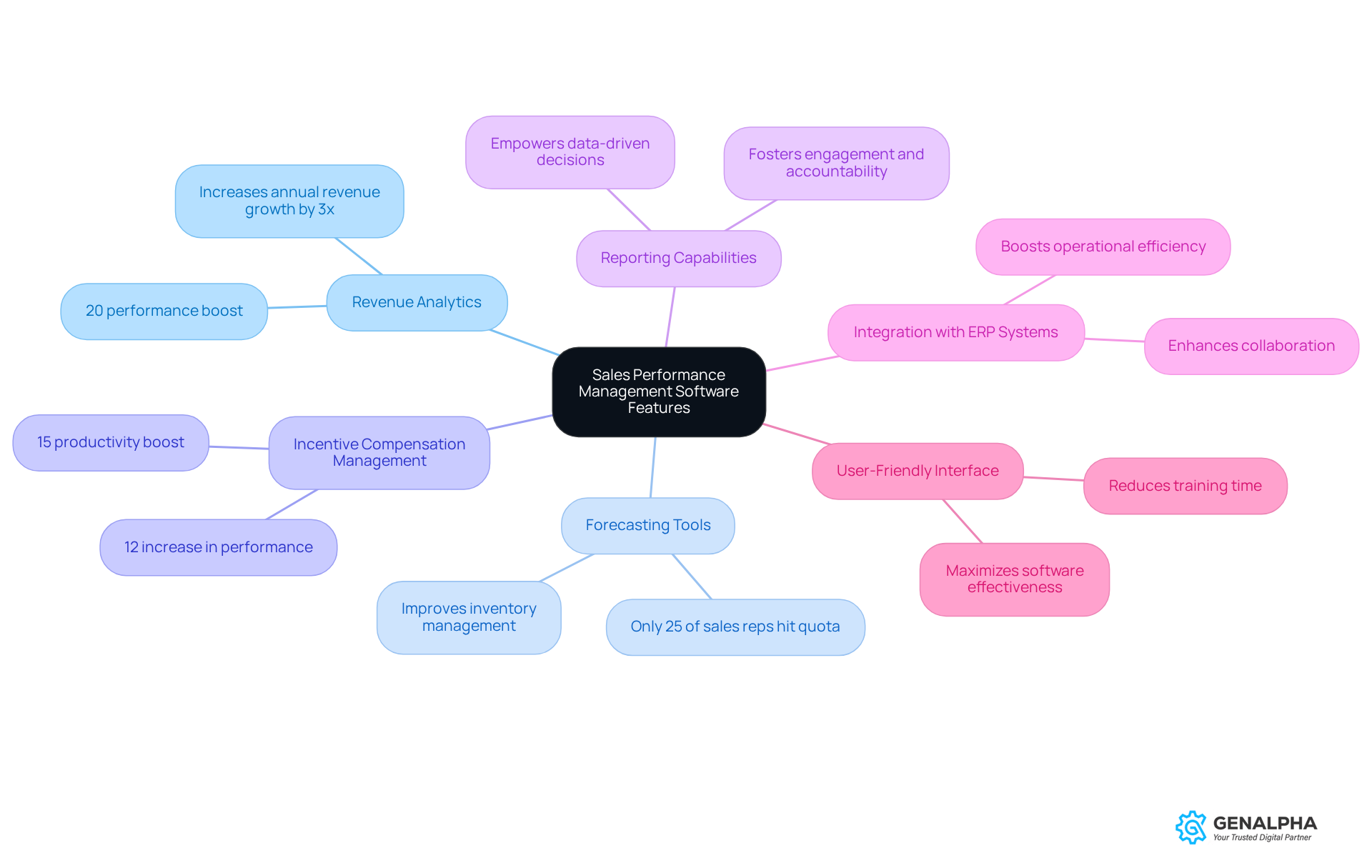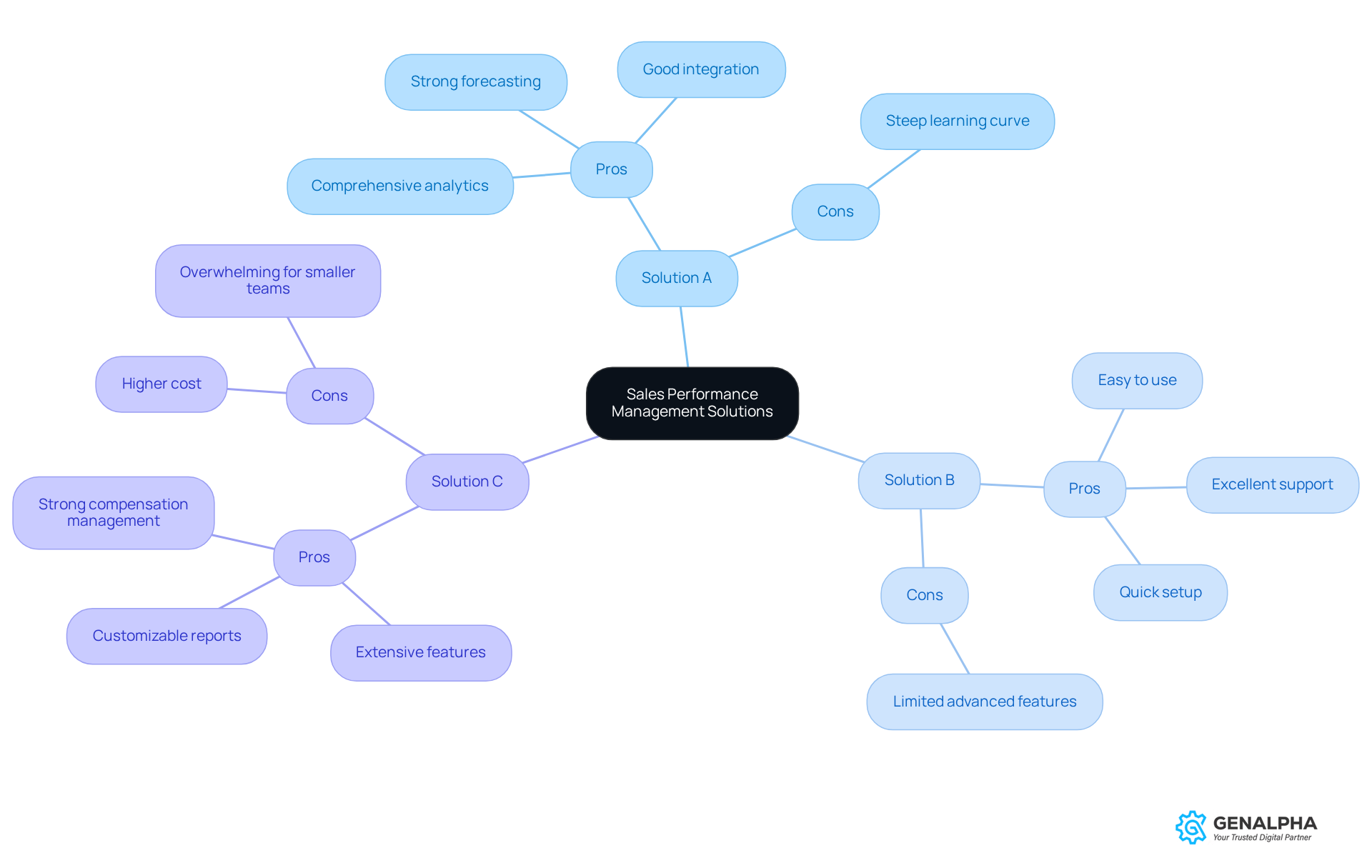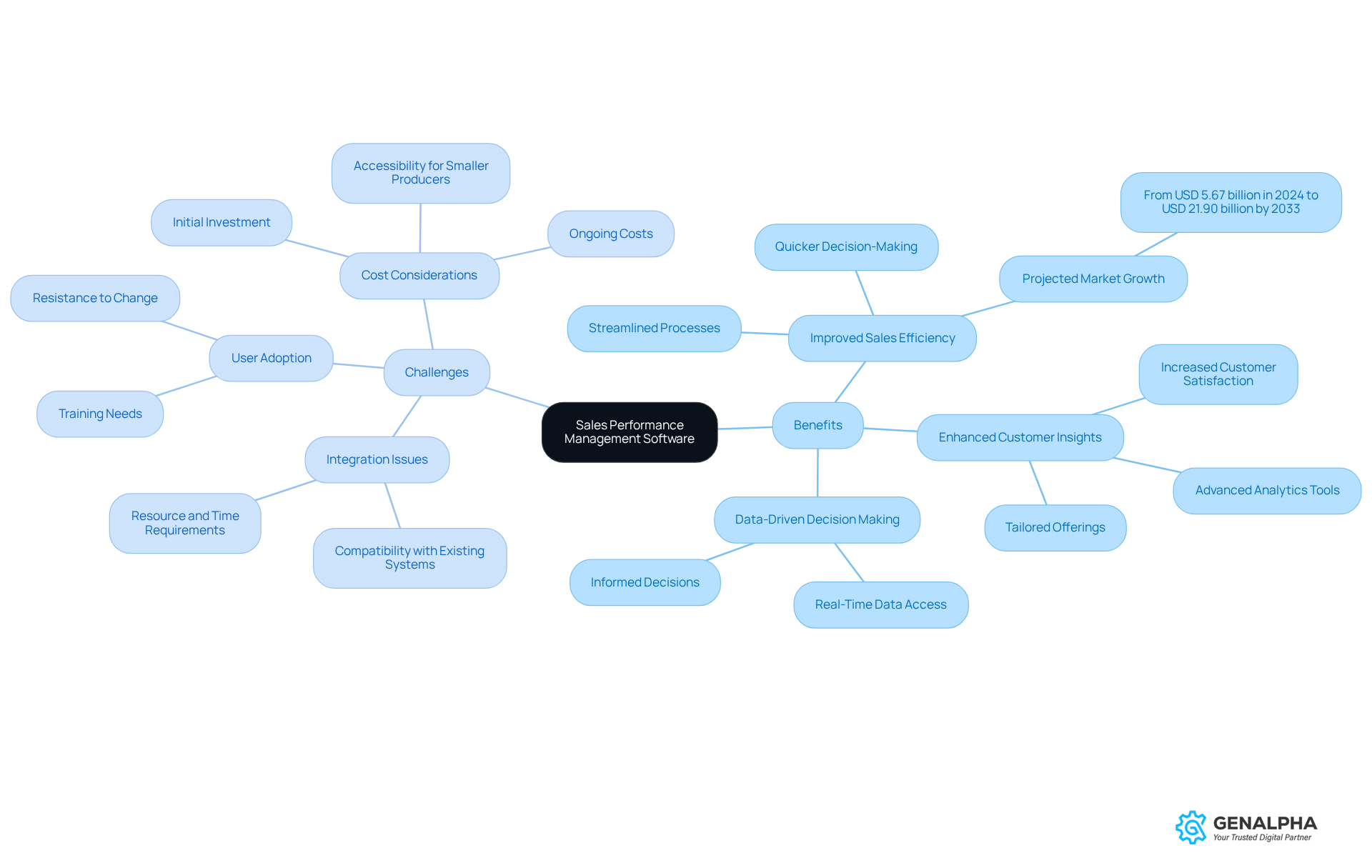Overview
Have you ever wondered how the right software can transform sales for manufacturers? This article dives into the world of sales performance management (SPM) software, focusing on its impact on manufacturers. We’ll explore the key features, benefits, and even some challenges that come with implementing these solutions.
Choosing the right SPM tool isn’t just a tech decision; it can seriously boost your sales efficiency and provide deeper insights into customer behavior. Imagine having data at your fingertips that shows how the market is growing and how companies that embrace these tools are seeing real improvements in their revenue. Sounds pretty appealing, right?
So, what are you waiting for? Let’s unpack this together and see how the right SPM solution could be a game-changer for your organization!
Introduction
Have you ever felt overwhelmed by the sheer number of choices when it comes to sales performance management software? You're not alone! For manufacturers looking to boost their revenue processes and foster growth, these tools have become essential. With features like forecasting, territory management, and performance analytics, they empower businesses to make smart, data-driven decisions that resonate with market demands.
But here's the catch: with so many options out there, how do you choose the right software? It’s not just about meeting operational needs; you also have to consider integration challenges and how easily your team will adopt the new system. So, which sales performance management solution will rise to the occasion in this ever-evolving landscape? Let’s dive in and explore the possibilities together!
Understanding Sales Performance Management Software
Sales performance management software is essential for producers looking to optimize their revenue processes. Think of sales performance management software as your trusty sidekick in tracking, analyzing, and improving sales performance. They bring together key elements of sales administration—like forecasting, territory management, and performance analytics—so you can gain actionable insights from your sales data. By using sales performance management software, manufacturers can spot trends and make informed decisions that truly drive revenue growth.
What makes SPM applications stand out? Well, they come packed with advanced sales performance management software that includes sales analytics, incentive compensation management, and comprehensive reporting tools, all tailored to the unique needs of the manufacturing sector. For instance, organizations using these tools have reported improvements in revenue cycle durations by up to 20%. That's a clear sign that sales performance management software can refine marketing strategies and enhance customer interactions.
Looking ahead, the SPM market is on the rise, projected to grow from USD 2.95 billion in 2025 to USD 6.58 billion by 2030, with a CAGR of 17.43%. Manufacturers are increasingly recognizing the value of adopting these solutions. The latest trends show a shift towards cloud-based systems and AI integration, which boost real-time analytics and operational efficiency. Industry leaders emphasize that enhancing sales processes through sales performance management software not only aligns revenue goals with business objectives but also fosters a customer-focused strategy—vital for thriving in today’s competitive landscape. Plus, the successful application of SAP SuccessFactors by Kyndryl highlights the real-world benefits of SPM tools, demonstrating how they can streamline sales workflows and improve overall performance.

Key Features of Sales Performance Management Software for Manufacturers
When you're on the hunt for sales performance management software tailored for manufacturers, a few key features really stand out as must-haves for boosting sales performance.
-
Revenue Analytics: Think of this feature as your sales compass. It provides valuable insights into performance metrics, helping you spot your top products and winning marketing strategies. Many organizations that dive into revenue analytics see a significant bump in income—those using sales performance management software often report three times the annual revenue growth compared to their peers. Plus, companies that utilize sales performance management software through tech solutions experience a 20% performance boost, proving just how crucial analytics can be.
-
Forecasting Tools: Accurate revenue predictions are vital for keeping inventory in check and scheduling production effectively. By digging into historical data, manufacturers can better anticipate demand, which leads to smoother operations and lower costs. However, it’s worth noting that only about 25% of sales reps typically hit their quota, highlighting how essential efficient forecasting tools are for reaching those revenue targets.
-
Incentive Compensation Management: Automating commission and bonus calculations keeps your sales team motivated and fairly rewarded. Organizations with solid incentive plans have seen a 12% performance increase, and effective incentive programs can boost productivity by up to 15%. It’s clear that this feature plays a significant role in driving success for sales performance management software.
-
Reporting Capabilities: Customizable reporting tools let manufacturers track their performance against key performance indicators (KPIs), empowering them to make informed, data-driven decisions. Regularly sharing these metrics fosters engagement and accountability within sales teams.
-
Integration with ERP Systems: Seamless integration with existing Enterprise Resource Planning (ERP) systems is crucial for ensuring smooth information flow across departments. This connectivity not only enhances collaboration but also boosts operational efficiency—essential in today’s fast-paced manufacturing landscape.
-
User-Friendly Interface: A simple, intuitive interface is key to user acceptance and cuts down on training time for your sales team. While ease of use is vital for maximizing software effectiveness, specific stats on user adoption and training time could really drive this point home.
Together, these features supercharge the selling process, elevate customer interactions, and streamline operations through sales performance management software. They’re indispensable for manufacturers looking to thrive in a competitive market. For instance, companies that invest in training and analytics typically enjoy a 20-30% performance increase, underscoring just how important these tools are for driving growth.

Comparative Analysis of Leading Sales Performance Management Solutions
In this comparative analysis, let’s dive into three leading Sales Performance Management solutions designed specifically for manufacturers:
-
Solution A: This one is well-known for its robust analytics capabilities. It offers advanced forecasting tools and integrates seamlessly with ERP systems. However, keep in mind that it may require some extensive training for new users.
- Pros: Comprehensive analytics, strong forecasting, good integration.
- Cons: Steep learning curve.
-
Solution B: If user-friendliness is what you’re after, this solution excels in that area and comes with excellent customer support. It’s especially beneficial for smaller producers looking for a quick setup.
- Pros: Easy to use, excellent support, quick setup.
- Cons: Limited advanced features compared to competitors.
-
Solution C: This feature-rich platform includes incentive compensation management and customizable reporting. It’s optimal for larger producers with complex distribution frameworks.
- Pros: Extensive features, customizable reports, strong compensation management.
- Cons: Higher cost, may be overwhelming for smaller teams.
By comparing these solutions, producers can figure out which program best fits their operational needs and budget constraints. Did you know the Sales Performance Management sector is projected to grow at a CAGR of 13.6% from 2023 to 2028? This growth highlights the importance of selecting the right sales performance management software to improve sales effectiveness and achieve strategic goals. As Peter F. Drucker famously said, efficient management is key to boosting performance, making the choice of sales performance management software a crucial factor in a producer's success. Plus, the implementation of Anaplan at Schneider Electric offers a real-life example of how tailored SPM solutions can significantly improve operational efficiency. So, which solution do you think would work best for you?

Benefits and Challenges of Implementing Sales Performance Management Software
Implementing sales performance management software can be a game-changer for manufacturers, offering a mix of benefits and challenges that can really shake things up in their operations.
Benefits:
- Improved Sales Efficiency: Imagine streamlined processes and easy access to data—this means quicker decision-making and a boost in sales productivity. In fact, the worldwide revenue performance management market is projected to grow from USD 5.67 billion in 2024 to USD 21.90 billion by 2033. That’s a compound annual growth rate (CAGR) of 16.20%! Clearly, the need for these efficiencies is on the rise.
- Enhanced Customer Insights: With advanced analytics tools at their fingertips, producers gain valuable insights into customer behavior. This allows them to tailor their offerings and ramp up customer satisfaction. Companies using AI-driven analytics are reporting better resource allocation and proactive strategy tweaks, which means even more sales productivity.
- Data-Driven Decision Making: Real-time data access is like having a crystal ball for manufacturers, enabling them to make informed decisions that align with market demands. And let’s be honest, in a rapidly growing market, this is crucial.
Challenges:
- Integration Issues: Now, let’s talk about the hurdles. Integrating new SPM software with existing systems can be quite the headache, often requiring extra resources and time. Many organizations are still stuck with outdated infrastructure, making the shift to modern solutions a bit tricky. This can lead to delays in reporting and increased costs.
- User Adoption: Getting sales teams on board with the new system can feel like herding cats. It often takes comprehensive training and ongoing support to make it happen. A survey revealed that nearly one-quarter of respondents had no plans to adopt SPM applications, highlighting the need for strategic change management to tackle that reluctance.
- Cost Considerations: Let’s not forget about the money. The initial investment and ongoing costs of SPM applications can be hefty, especially for smaller producers. While subscription-based pricing models are making things a bit more accessible, the overall financial commitment is still a big deal, particularly for small and medium-sized companies facing high acquisition costs and implementation challenges.
By understanding these benefits and challenges, manufacturers can make informed decisions about implementing sales performance management software and develop effective strategies for a successful transition. So, what’s holding you back from exploring this opportunity?

Conclusion
Sales performance management software is becoming a game changer for manufacturers looking to boost their revenue processes and fuel growth. By bringing together key features like sales analytics, forecasting, and incentive compensation management, these solutions help organizations make smart, data-driven decisions that align with their goals. As more manufacturers recognize the value of these tools, it’s clear they play a crucial role in optimizing sales performance and developing customer-focused strategies.
Let’s dive into what makes sales performance management software so essential. Think about:
- Revenue analytics
- User-friendly interfaces
- Smooth ERP integration
These features not only simplify the process but also make it easier for teams to adapt. We’ll also explore a comparative analysis of top solutions, highlighting their unique strengths and potential drawbacks. Sure, implementing this software can lead to improved sales efficiency and deeper customer insights, but it’s important to weigh those benefits against challenges like integration, user adoption, and cost.
At the end of the day, choosing the right sales performance management software is crucial. With the market constantly evolving, manufacturers should definitely consider these tools to enhance their sales processes and stay competitive. Embracing these solutions can lead to significant operational efficiencies and a stronger connection between revenue goals and business strategies. So, why not take that step towards sustained success in the manufacturing sector? Let’s explore the possibilities together!
Frequently Asked Questions
What is sales performance management software?
Sales performance management software is a tool that helps producers optimize their revenue processes by tracking, analyzing, and improving sales performance. It integrates key elements of sales administration, such as forecasting, territory management, and performance analytics, to provide actionable insights from sales data.
What are the key features of sales performance management software?
Key features include sales analytics, incentive compensation management, and comprehensive reporting tools specifically tailored for the manufacturing sector.
How can sales performance management software benefit manufacturers?
By using sales performance management software, manufacturers can identify trends, make informed decisions, and drive revenue growth. Organizations have reported improvements in revenue cycle durations by up to 20% when utilizing these tools.
What is the projected growth of the sales performance management market?
The sales performance management market is projected to grow from USD 2.95 billion in 2025 to USD 6.58 billion by 2030, with a compound annual growth rate (CAGR) of 17.43%.
What trends are emerging in sales performance management software?
Emerging trends include a shift towards cloud-based systems and the integration of artificial intelligence (AI), which enhance real-time analytics and operational efficiency.
How does sales performance management software align with business objectives?
It enhances sales processes by aligning revenue goals with business objectives and fostering a customer-focused strategy, which is crucial for success in a competitive landscape.
Can you provide an example of a successful application of sales performance management software?
The successful application of SAP SuccessFactors by Kyndryl demonstrates how SPM tools can streamline sales workflows and improve overall performance.




